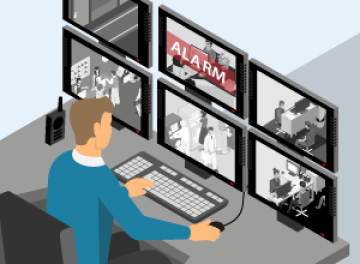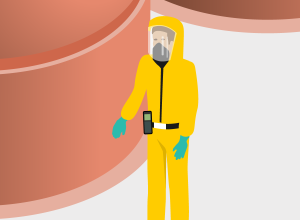© tetronik GmbH. All rights reserved.
© tetronik GmbH. All rights reserved.
Preventing Violence and Protecting Employees in the Workplace with 'Silent Alarm'
Summon help quickly and inconspicuously
In employment agencies, social offices and courts, employees in workplaces with customer contact are increasingly exposed to aggressive behavior from upset citizens. Particularly during one-on-one interviews or interrogations, verbal conflicts often escalate into assaults involving physical or psychological violence. This can certainly have health consequences for those affected: Stress symptoms, anxiety and loss of motivation cause more frequent days of absence, they impair productivity and worsen the working atmosphere. Damage to property can also generate considerable costs and cause lasting disruption to operational processes.
Managers of public authorities are therefore encouraged to protect their administrative employees through efficient alarm systems, regular employee training and suitable emergency plans. Unfortunately, the installation of alarm buttons is often not only structurally problematic – the untypical hand movement to the alarm button can promote escalations. The lack of feedback to the person seeking help after pressing the button also does not contribute to their sense of security. Truly effective solutions must therefore be both absolutely inconspicuous and structurally feasible in any environment.

This is how the wilent alarm helps prevent violence in the workplace

An employee triggers an alarm inconspicuously
Sabrina works in an office of the public law and has a rather tense conversation with a customer. As soon as the customer's behavior or speech develops in an inappropriate way and Sabrina starts to feel uncomfortable in the customer conversation, she can discreetly inform her colleagues from the surrounding offices. She does so by clicking a virtual alarm button on her desktop or by using a predefined key combination - an action that goes unnoticed by the customer because it appears to be a normal work activity.

The alarm goes unnoticed by the customer
This particular inconspicuousness of triggering the alarm allows Sabrina to start the process at a very early stage in her conversation without aggravating the situation with the customer in any way. Due to the silent alarm without sounds or other signals, the started alarm process remains unobtrusive. Only Sabrina is shown a discreet message about the started alarm process on her monitor, which is not understandable for strangers and gives her a sense of calm.

Colleagues in adjacent offices come to the rescue
The DAKS alarm server immediately forwards the alarm to the assigned colleagues in the surrounding offices. They receive the emergency call displayed on their desktop or are called on their phones. They can then join in "as if by chance" to provide support, e.g. with a question as a pretext. Experience has shown that in many cases, the mere appearance of a colleague leads to de-escalation and averts danger. The threatening situation can thus be gently resolved and violence avoided, even without requiring the security service to intervene.

Everyone responsible is informed
Alongside her colleagues, the security service or the control center can also receive the alarm along with the location information in order to keep an eye on the situation and intervene if necessary. Sabrina feels safe because she knows that she can count on the reliable alerting with DAKS and on her colleagues.

The alarm process is logged and evaluated
With DAKS, all alarm processes are logged in detail. This is important for the follow-up of actual incidents. Exercise alarms are also logged – these provide important insights that can be used to optimize alarm processes. The logs can also be supplemented with manual entries (e.g. for false alarms or abnormalities). It is particularly important to regularly practice both alarm triggering and the response of colleagues and the security service. This way, everyone is well prepared to help each other and to act confidently in threatening situations.
Benefits of the inconspicuous alarm triggering with DAKS

More security for employees
- The philosophy of mutual support among colleagues and the awareness of being able to avert a conflict in an uncomplicated and discreet manner at a very early stage gives employees security and favors the working atmosphere and work motivation.
- Regular, realistic exercises with DAKS at various levels, all the way to evacuations, help employees to intuitively act in the right manner in difficult situations. Logging is the perfect basis for analyzing and continuously improving processes.

Simple implementation and many possible applications for those responsible
- DAKS supports the structural, technical and organizational strategies recommended by the police, the employer's liability insurance association and threat managers in many places: In addition to the described alerting options in the direct work environment, it maps effective alerting procedures for a variety of different threat levels.
- Since the virtual alarm button is an app, no additional cables need to be installed – corresponding construction measures are not required.
- DAKS can already be used in advance to prevent many a dangerous situation from arising in the first place. For example, the alarm server alerts you when personnel doors are open and allow unauthorized persons access to protected employee areas.
- Follow-up work is preparation: Incidents can be followed up comprehensively and processed on the basis of the complete documentation.
Video of the solution
Discuss your individual
application project with us
Add this solution
to your shortlist
Related Application Examples

Assemble Winter Road Maintenance Flexibly and Reliably

Set up Citizen Hotline for Current Events

Alone, but Not Abandoned: Protecting Lone Workers in Accordance with DGUV (German Social Accident Insurance)
- Home
- Applications
- Public Administration
- Preventing Violence and Protecting Employees in the Workplace with 'Silent Alarm'
© tetronik GmbH. All rights reserved.





